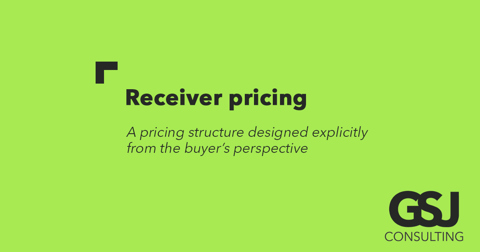Receiver pricing: a procurement-led perspective

Whether we like it or not, procurement plays a significant role in the selection of outside suppliers these days. That has now extended to suppliers of professional services, and wherever you find procurement, you know pricing is going to be central to any negotiations. However, it’s not pricing in the traditional sense of “how much will it cost”, but rather, what the value is for the fee.
Receiver pricing is a relatively new concept to professional service suppliers. In short, it is structured from the perspective of the purchaser/buyer of your service, not the more traditional model of the seller setting the price.
What is receiver pricing?
Receiver pricing refers to pricing structures designed explicitly from the buyer’s perspective. It involves shifting from a supply-led model (what professionals think their services are worth) to a demand-led model (what the client perceives as valuable and is willing to pay for, under procurement constraints).
Under this model, pricing is not just about cost but about value transfer: how clearly a solution solves a business problem or mitigates risk in a way that justifies the spend.
Receiver pricing from a procurement perspective
Procurement teams, often tasked with sourcing professional services across legal, finance, consulting, and IT, are increasingly sophisticated in how they evaluate proposals using criteria such as commercial compliance, total cost of ownership, supplier risk, and demonstrable ROI.
Receiver pricing acknowledges these filters and works within them, not around them.
As procurement teams draw on compliance and other related data to become even more sophisticated in how they engage external service providers, service providers will need to move away from the default billable hour pricing structure. Professional services firms need to get into the mindset of procurement teams to create pricing models that speak directly to the needs of the client: predictability, value assurance and performance aligned.
Why receiver pricing matters in professional services
Procurement professionals don’t buy time; they buy outcomes, risk reduction, and confidence. If your pricing structure doesn't reflect that, your proposal may look uncompetitive, even if your credentials are impeccable.
Three reasons to adopt a ‘receiver pricing’ model
-
Alignment with procurement metrics
Procurement teams are looking for quantifiable value: cost avoidance, litigation prevention, contract acceleration, and compliance assurance. Professionals who tie pricing to these outcomes, through KPIs, milestones, or incentive models, will stand out.
Receiver pricing allows professionals to speak the same language as procurement, using commercial logic rather than jargon.
-
Predictability and control
Buyers dislike budget blowouts and open-ended commitments. Hourly rates may offer flexibility for professionals, but they create uncertainty for clients.
Receiver-focused pricing provides structures like:
-
- capped fees with success bonuses;
- tiered pricing based on deal size or risk exposure;
- subscription models for continuous work.
These models give procurement greater cost control and improve internal budget forecasting, which is critical in a competitive sourcing environment.
-
Procurement-friendly differentiation
Many professionals struggle to differentiate themselves from their competition. Receiver pricing is a powerful tool to differentiate yourself because it demonstrates commercial empathy. It signals that your firm understands how the client buys, not just how you sell.
Overcoming challenges to implement receiver pricing
While the benefits are clear, there are obstacles to understanding and implementing a receiver pricing strategy, both internal and external.
Professionals are reluctant to move away from time and materials-based pricing, fearing under-recovery or increased risk. Procurement teams, meanwhile, may resist overly complex or opaque pricing structures.
Here’s how to address these concerns:
- Educate internally: Train partners and pricing teams to engage with procurement's logic. Not every matter needs a bespoke model, but client-facing teams should be equipped to discuss pricing from a commercial standpoint.
- Use transparent assumptions: Base pricing on understandable metrics, such as matter type, jurisdiction, and likely outcomes. That way, procurement can validate your value proposition.
- Pilot and iterate: Start with a key client or a common matter type. Test new models in a low-risk setting before scaling across the firm.
Final thoughts: price the way clients buy
Receiver pricing is not about being cheaper: it’s about being easier to buy from.
In an era where client spend is very much under scrutiny, and where procurement's influence is ever growing, professionals who can think like buyers will win more work and build deeper client trust.
By designing pricing models that reflect how value is perceived, and not just how time is spent, professionals can reposition themselves not as vendors, but as strategic partners.
And that’s a position procurement teams are far more likely to say yes to.
Contact GSJ Consulting
We can help you Aquire, Retain, Grow
The information contained in this article is of general nature and should not be construed as professional advice. If you require further information, advice or assistance for your specific circumstances, please contact us.
